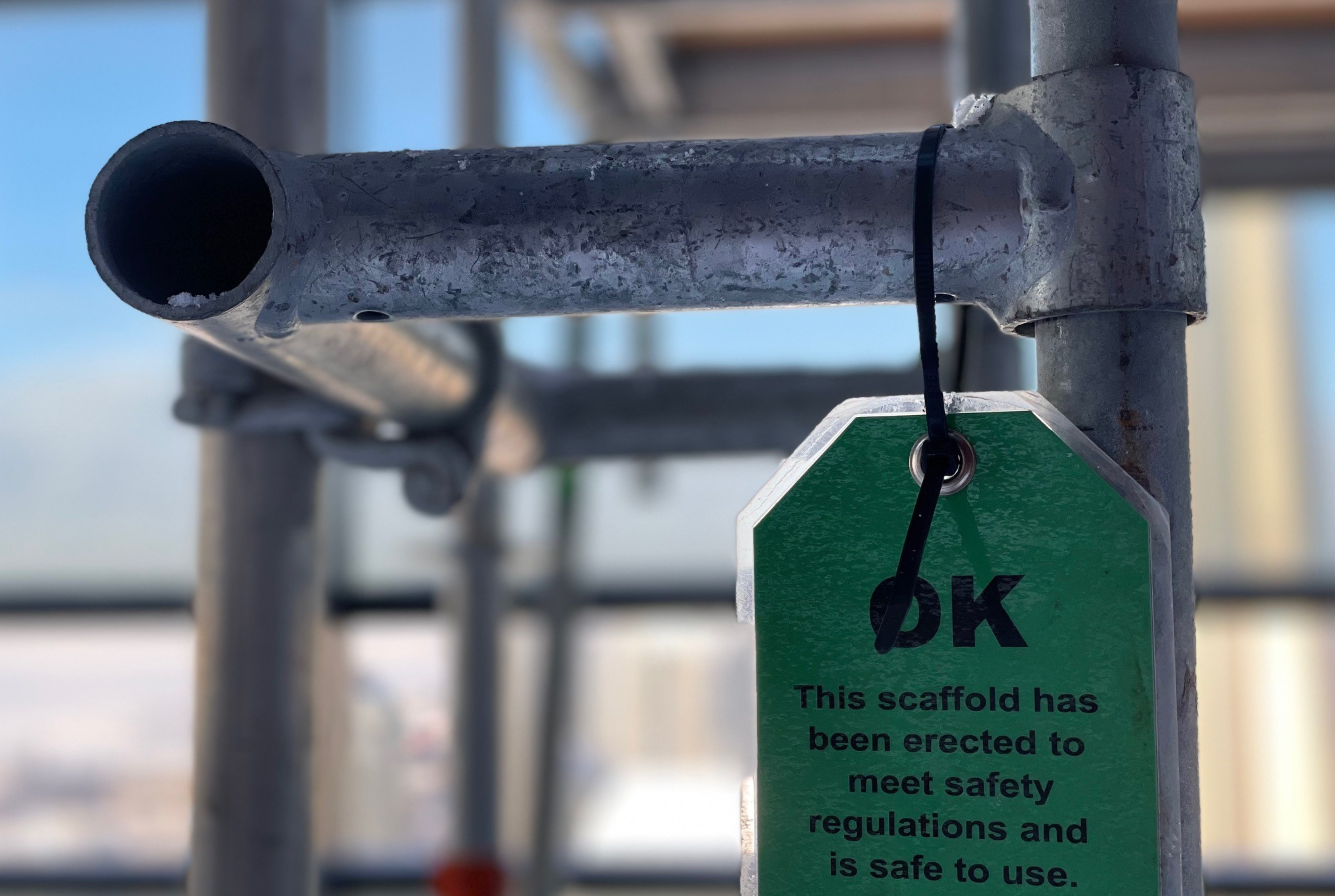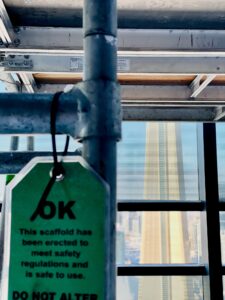
A scaffold inspection is a careful examination of any scaffold being erected or that has been erected to ensure that it is safe to work on for both the safety of construction workers and passers-by.
Keeping workers and bystanders safe on construction sites is paramount. That’s why an essential part of any scaffolding set-up procedure involves a thorough inspection.

According to the Infrastructure Health and Safety Association, the following must be completed during a general inspection of a scaffold:
- Confirm that erectors followed the design drawing before the scaffold is used
- Identify any defect of the structure, supports or accessories
- Verify that all safeguards are correctly installed
- Verify that the use and load of the scaffold correspond to the structural specs of the scaffold
- Confirm that the scaffold is maintained in good condition and has no deformations
Additional written inspections must be completed after installation and before use of the scaffold to confirm that it is safe for work to commence. Inspections should also be done before each use and after each modification.
If there are any circumstances (i.e. extreme weather conditions) that might threaten the safety of the scaffolding, then the scaffold should be inspected right away even if there was a recent inspection.
NOTE: that following inspection for any scaffold over 50 feet, a report should be created by a licensed professional engineer and kept on site until the work is completed. Otherwise, read on to find out who can inspect scaffolding under 50 feet.
Who can perform scaffold inspections?
Inspections of scaffold structures under 50 feet can be carried out by a designated “Competent Person”, “Engineer” or “Inspector” whose combination of knowledge, training and experience is appropriate for the type and complexity of the scaffold. As aforementioned, all scaffolds over 50 feet must be inspected by a licensed professional engineer.
In most cases, scaffold inspections are part of the service provided by scaffold erectors and scaffold companies. There is also the option to hire an independent inspection service or to train an employee to preform inspections, but we highly recommend you review your local regulatory requirements and do your due diligence before making this an internal role.
When is a licensed structural engineered required?
In addition to the 50-foot rule, there are a few other factors that could require the design and inspection to be completed by a licensed Structural Engineer. These requirements can vary depending on your provincial regulations, but are often based on the following:
- Height
- Center pole scaffold
- Enclosure
- Re-shoring applications
- Suspended
For more information on scaffold inspections and requirements review applicable CSA Standards, local regulatory requirements and contact your scaffold manufacturer for instructions and user guide.
What does a scaffold inspection include?
In the event that an inspection report is required, the report should include:
- name, number, or location that provides a distinct identification of the scaffold;
- date of completion or alteration, and last inspection of the scaffold;
- name of the license professional engineer verifying the scaffold; and
- duty rating (load rating) of the scaffold.
Additionally, the scaffold must be prominently displayed at each point of entry (from ground level and any other access point to the structure) to the scaffold. Placement, removal, and marking of scaffold tags must be done only by a qualified and competent person. The tags must indicate the safety status of the scaffold and should indicate one of the following:
| Colour of Inspection Tag | Wording to Appear on Tag |
| Green | “Safe for Use” or similar wording |
| Yellow | “Caution: Potential or Unusual Hazard” or similar wording |
| Red | “Unsafe for Use” or similar wording |
Scaffold Inspections are Essential
It is essential to keep scaffolds regularly inspected in order to make sure that they are safe for workers, property, and passers-by. Scaffold inspection is a vital safety measure for any construction project for the protection of all involved. Regular inspections can detect issues with the structure early on and prevent more serious damage from occurring. Moreover, it can save you money – preventive measures cost a fraction compared to the cost of dealing with an accident if workers were injured due to insufficient caution.
All in all, making sure that scaffolds get regularly inspected helps provide everyone involved with greater peace of mind that their safety is ensured and taken into account before every job begins. If you are unsure about the safety of a structure or have any questions about it, seek out an experienced structural engineer or contact the erector of the scaffolding before use.
Have more questions? Contact one of our scaffold experts here.
This article is form informational purposes only and not meant to replace regulation guidelines. Always verify your local regulatory and CSA standards for inspection tagging and frequency requirements.




